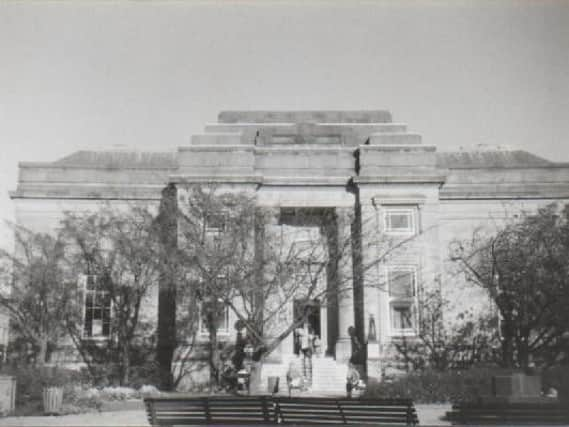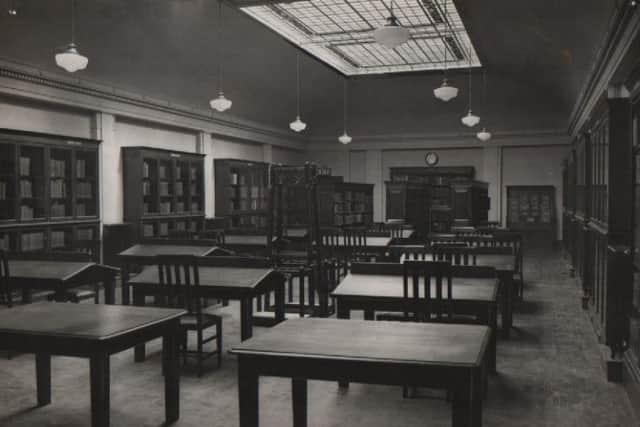Positive signs for the future


It had cost £37,500 to construct and furnish the building, almost half of which was met by a grant from the Carnegie Trust. The other £21,000 came from the County Borough of Burnley but neither of these sums included the cost of the books.
In a Library the latter were, of course, the most important commodity but it was not the case that the Council had, in this respect, to start from scratch. There were books in the Public Reference Library, which had occupied the Old Town Hall on Elizabeth Street since 1921, and these were transferred to the new premises on Grimshaw Street once they were ready. Of course, there were books at the Marshall and Colne Road libraries.
Advertisement
Hide AdAdvertisement
Hide AdThere are several sources which give us an idea of what the first years of the Grimshaw Street Library was like. One of the best is the entry, entitled “Public Library”, in the 1933 Commercial Directory of Burnley, the first to mention the new building. It describes the building as being of steel frame construction (as was shown in one of last week’s photographs) the external walls being faced, on all four sides, with ashlar, the stone being from the Stancliffe quarries, Darley Dale in Derbyshire.


The design of the building is said to have been “bold and simple”, two words which do not always sit well together. A feature was made of the portico to the main entrance off Grimshaw Street which was set back 52 feet to provide a “spacious forecourt with (an) ornamental garden”.
Last week I referred to my belief that George Harling, the architect of the Central Library, was influenced by Howard Carter’s discovery of the tomb of Tutankhamen in the Valley of the Kings in 1922. This can be seen in the cartouche-like symbol, above the portico, and the general shape of the building, which is very reminiscent of a mastabar, an early Egyptian tomb. All that said, whilst the building was architecturally inspirational in the mode of much older libraries, it was very practical in a 20th Century sort of way.
The Commercial Directory says, “The building is of two storeys in height above the ground floor, excepting the Lending Library which is (of) one storey. A basement has been provided under the whole of the building”.
Advertisement
Hide AdAdvertisement
Hide AdMany of the original elements of the building can still be determined today. Of these, the Lending Library is the easiest to identify but the newsroom, a ladies magazine room and the first site of the Massey Music Library have been lost in a general re-organisation of the ground floor, and indeed the whole building, which took place in the early 1990s.


On the first floor there was, when the Library first opened, a Reference Library and a Children’s Library and Reading Room. The former was designed so that it could also provide the space for lectures. The basement had one large work and storage room having an area of 6,930 square feet. The panelling and furniture on the ground floor was originally of mahogany, that on the first floor of oak. I recall the heavy oak chairs in the Reference Library as being very uncomfortable but this did not seem to trouble its many users all that much.
In the 1930s Burnley Central Library was regarded as “one of the best equipped libraries in the country” and, at that time, the whole of the service had over 61,000 books available for lending and reference. In 1932 the town had a population of almost 100,000 of which there was a total of 23,036 registered borrowers who borrowed over one million books, from all the town’s libraries. Another way of presenting these figures would be to say that every citizen of Burnley, no matter what their age might have been, took out about 11 books a year!
In addition to the Central Library, the Marshall Branch Library and the Colne Road Branch Library, both of which were older than the Central, remained active in the 1930s. These were joined by three “distributing stations” in the “outlying districts” though the term applied only to the outlying districts of the then County Borough. The premises were at 323 Manchester Road (Rosehill Post Office); 56 Lowerhouse Lane, Rosegrove and 109 Oxford Road. All of them remained shop premises.
Advertisement
Hide AdAdvertisement
Hide AdIt is clear that 1930 is an important year in the history of the Burnley Library Service. It had taken the Council some time to get to this point – a Central Library of which the town could be proud – but, with the opening of the building on Grimshaw Street, this had certainly been achieved. In fact it is often the case that we forget the context of the time in which significant advances like this took place.
The 1920s is not merely characterised by the discovery of the tomb of an Egyptian boy-king. It had only been in 1919 that the peace treaties which brought the First World War to a conclusion were signed. In 1921 the Irish Free State, with Dominion status, was established. By 1922 the short-lived period of prosperity, which followed the end of the War, came to an end. In 1925 Britain returned to the Gold Standard which had the effect of increasing already advancing unemployment. This was followed by the General Strike in 1926 and the Wall Street Crash in 1929.
It is easy for us to see, in retrospect, what was happening. By the 1930s the world, with the rise of the European dictatorships, was on its way to another Great War but had Burnley Council known this, would they have proceeded with the building of the Central Library? Perhaps not, but it should be added that, even in the depths of the Depression of the 1930s, Burnley found ways to increase the job opportunities for those whose employment in the textile trades was coming to an end. It could be that, for Burnley Central Library, its time had come.
Of course, the jobs Burnley found for its people, at this time, were in the newer industries but, somehow, Burnley, when, in lots of respects, things were looking particularly parlous, seemed to acquire a confidence that it once did not appear to have. The Library of 1930, the opening of Thompson Park, the new head offices of the Burnley Building Society (under construction at this time) and the plans being made for the Prestige factory (together with those for a Municipal Airport for the town which did not materialise) were all positive signs for the future at what was a depressing time.
Next week we will conclude the story of the Library Service in Burnley.